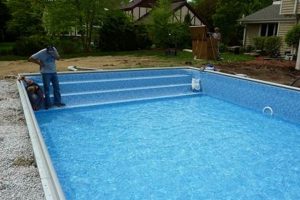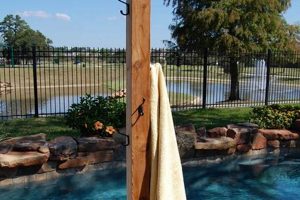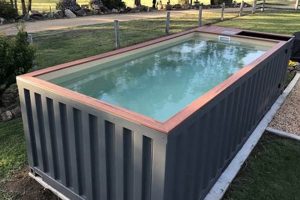Creating a personal aquatic space within the confines of a smaller area is a growing trend in residential design. This approach often involves innovative use of readily available materials and a self-directed construction process. Examples include modifying stock tanks, repurposing shipping containers, or employing pre-fabricated kits for ease of assembly.
Implementing a compact, individually-designed swimming area presents several advantages. Cost-effectiveness is a primary driver, as professional installation and custom designs frequently carry significant expense. Additionally, personalization options abound, allowing homeowners to tailor the aesthetic and functionality to specific needs and preferences. Historically, resourcefulness in construction has been a hallmark of adaptable home improvement strategies, reflecting both economic constraints and a desire for self-sufficiency.
The subsequent discussion will detail the considerations for planning, design, material selection, construction techniques, safety precautions, and maintenance strategies associated with the implementation of a diminutive, self-constructed aquatic retreat.
DIY Small Pool
Constructing a personal, scaled-down aquatic feature requires careful planning and execution. The following recommendations are designed to guide the process, ensuring a safe and functional result.
Tip 1: Site Assessment. Prior to any excavation or material acquisition, thoroughly evaluate the intended location. Consider soil composition, proximity to utilities, drainage patterns, and sunlight exposure. A geotechnical survey may be necessary for unstable ground conditions.
Tip 2: Code Compliance Verification. Research all applicable local building codes, permitting requirements, and safety regulations governing private swimming pool construction. Failure to comply can result in fines and mandated remediation.
Tip 3: Structural Integrity Focus. Whether using stock tanks, containers, or custom frames, prioritize structural integrity. Reinforce walls and floors to withstand hydrostatic pressure. Consult with a structural engineer if design deviates significantly from standard practices.
Tip 4: Water Management System Design. Incorporate a robust filtration and circulation system to maintain water quality and hygiene. Select a pump and filter appropriate for the water volume and bather load. Chemical balance is critical.
Tip 5: Safety Barrier Implementation. Install a secure barrier around the pool area to prevent unauthorized access, particularly by children. The barrier should meet or exceed local code requirements regarding height, latching mechanisms, and clearances.
Tip 6: Electrical Grounding Precautions. Ensure all electrical components, including pumps and lighting, are properly grounded to prevent electrical shock hazards. A licensed electrician should perform all electrical work.
Tip 7: Liner Selection Considerations. When using a liner, choose a durable, UV-resistant material specifically designed for pool applications. Proper installation is essential to prevent leaks and premature degradation.
The diligent application of these strategies will substantially enhance the safety, longevity, and enjoyment derived from the completed structure.
The subsequent section addresses the selection of suitable materials, construction techniques, and maintenance protocols.
1. Budgetary Constraints
The financial resources available for constructing a personal, scaled-down aquatic feature represent a primary determinant in project scope, design complexity, and material selection. Prudent allocation of funds is essential to balance desired features with practical limitations.
- Material Cost Optimization
Budgetary limitations necessitate a thorough evaluation of material options. Alternatives to conventional gunite or concrete, such as stock tanks, repurposed shipping containers, or prefabricated kits, offer significant cost savings. Careful sourcing and negotiation with suppliers can further reduce expenses. The trade-off often involves a reduction in customization options or a compromise on aesthetic preferences.
- Labor Reduction Strategies
A significant portion of overall project costs is often attributable to labor. The “do-it-yourself” approach inherently mitigates these expenses by transferring the majority of the construction tasks to the homeowner. However, this requires a realistic assessment of personal skill sets and time availability. Subcontracting specialized tasks, such as electrical work or plumbing, to qualified professionals is recommended to ensure safety and code compliance, despite the added expense.
- Equipment Investment Trade-offs
The selection of essential equipment, including pumps, filters, and sanitization systems, presents a financial decision point. While high-end, energy-efficient models offer long-term operational savings, the initial investment may be prohibitive. Striking a balance between upfront costs and projected energy consumption is crucial. Exploring used or refurbished equipment options can provide further cost reductions, provided that performance and reliability are not unduly compromised.
- Long-Term Maintenance Considerations
Budgetary constraints should not overshadow the ongoing maintenance costs associated with pool ownership. Chemical treatments, water replacement, and potential repairs represent recurring expenses. Selecting durable materials and implementing proper water management strategies can minimize these long-term financial burdens. A thorough understanding of projected maintenance requirements is essential for accurate budget planning.
The strategic management of budgetary constraints is paramount for successful implementation. Prioritizing essential structural components and safety features while strategically optimizing material and labor costs allows for the creation of a functional and enjoyable swimming area within defined financial parameters. Neglecting to consider long-term operational costs can lead to unsustainable expenditures, diminishing the overall value of the project.
2. Space Limitations
Space limitations represent a primary catalyst for the increasing prevalence of small, self-constructed aquatic features. As available residential land diminishes and housing densities increase, traditional full-sized swimming pools become less feasible for many homeowners. This restriction directly influences the adoption of innovative, space-efficient alternatives. The available area dictates the maximum dimensions and, consequently, the design approach. For example, a compact urban backyard may necessitate a stock tank conversion or a plunge pool configuration, whereas a larger suburban plot might accommodate a more expansive, albeit still scaled-down, custom design. Understanding these spatial constraints is crucial in the initial planning stages to ensure a viable and aesthetically harmonious addition to the property.
The correlation between spatial restrictions and project design extends beyond mere size reduction. It also informs material selection, construction methodologies, and equipment choices. Limited area may necessitate the use of lightweight materials to minimize structural load, influencing the choice of liners or prefabricated structures over poured concrete. Construction techniques must adapt to the confined workspace, potentially favoring modular assembly methods or utilizing specialized tools for restricted access. The selection of filtration and circulation systems must also consider spatial efficiency, prioritizing compact units that deliver adequate performance without consuming excessive area. Furthermore, zoning regulations pertaining to setbacks and pool enclosure requirements become even more critical when dealing with limited space, demanding meticulous planning and adherence to local ordinances.
In summary, space limitations are a defining factor in the design and implementation of small, self-constructed aquatic features. These constraints necessitate creative problem-solving, influencing material selection, construction techniques, and equipment choices. Understanding the practical implications of these spatial boundaries is paramount for achieving a functional, aesthetically pleasing, and code-compliant result, optimizing enjoyment while adhering to the physical realities of the available area. This connection highlights the importance of thorough site assessment and meticulous planning as foundational elements of any successful project.
3. Structural Integrity
Structural integrity is a non-negotiable aspect in the context of a self-constructed, compact aquatic feature. It directly relates to the safety, longevity, and overall viability of the installation. Compromises in this area can lead to catastrophic failures, posing significant risks to property and individuals.
- Hydrostatic Pressure Resistance
The walls of any pool, regardless of size, must withstand the considerable force exerted by the contained water. This hydrostatic pressure increases with depth and can cause deformation, cracking, or complete structural collapse if the design and materials are inadequate. Examples include the bulging or rupture of improperly reinforced stock tanks or the failure of insufficiently supported container pool walls. Proper reinforcement, using methods appropriate for the chosen materials, is essential to counter this pressure.
- Ground Stability and Soil Conditions
The underlying soil composition significantly impacts the structural stability of a aquatic feature. Unstable or expansive soils can shift over time, placing undue stress on the pool structure. This can lead to cracking, leaks, and eventual failure. Proper site preparation, including soil compaction and the possible incorporation of a reinforced concrete base, is crucial. Identifying and addressing potential soil issues prior to construction is essential.
- Material Selection and Compatibility
The choice of materials for pool construction directly affects its structural integrity. Materials must be compatible with water exposure, resistant to corrosion and degradation, and possess adequate strength to withstand the stresses imposed by the environment and the contained water. Using inappropriate materials, such as untreated wood or non-UV resistant plastics, can lead to premature failure. Selecting materials specifically designed for pool applications is essential.
- Joint and Seam Strength
The points where different components of a pool structure connect, such as welds in a container pool or seams in a liner, represent potential weak points. Improperly executed joints or seams can fail under stress, leading to leaks and structural instability. Utilizing appropriate joining techniques, ensuring proper welding procedures, and selecting high-quality sealants are critical for maintaining structural integrity. Regular inspection and maintenance of these connections are also essential.
In conclusion, the structural soundness of a self-constructed, compact aquatic feature hinges on a thorough understanding of hydrostatic pressure, soil conditions, material properties, and joint integrity. Diligence in these areas is paramount to ensuring a safe and durable installation, mitigating the risks associated with structural failure and maximizing the long-term enjoyment of the pool.
4. Filtration System
The integration of an effective filtration system is paramount in the construction of any self-implemented diminutive aquatic feature. Smaller water volumes are inherently more susceptible to rapid degradation in water quality. This necessitates a rigorous approach to removing particulate matter, organic contaminants, and other impurities. Absent adequate filtration, a “diy small pool” quickly becomes an unsanitary and potentially hazardous environment, fostering bacterial growth and algae blooms. For instance, a converted stock tank pool lacking proper filtration will require frequent and complete water changes, a resource-intensive and unsustainable practice. The causal relationship is direct: insufficient filtration leads to compromised water quality, impacting bather health and overall usability.
The selection of a suitable filtration system is contingent upon several factors, including the pool’s volume, bather load, and environmental conditions. Cartridge filters, sand filters, and diatomaceous earth (DE) filters represent common options, each with varying levels of efficiency, maintenance requirements, and cost. Cartridge filters, known for their ease of use and relatively low cost, may be suitable for very small pools with minimal bather load. Sand filters, while requiring more backwashing, offer a more robust filtration capacity for larger volumes. DE filters, providing the highest level of filtration, necessitate specialized equipment and careful handling of the DE media. Regardless of the chosen method, proper sizing and maintenance are critical for sustained performance. Neglecting regular cleaning or backwashing diminishes the filter’s effectiveness, rendering the entire system functionally useless. Successful examples include DIY systems utilizing repurposed aquarium filters for very small plunge pools or adapting in-ground pool filters for larger container pools.
In summary, the filtration system constitutes an indispensable component of any self-constructed, compact aquatic feature. Its primary function is to maintain water quality, preventing the proliferation of harmful microorganisms and ensuring a safe and enjoyable bathing experience. Selection criteria must consider pool volume, bather load, and environmental factors, while adherence to regular maintenance schedules is essential for sustained performance. Challenges often arise in balancing cost-effectiveness with filtration efficiency, requiring a careful assessment of available options. The successful integration of an appropriate filtration system directly contributes to the long-term viability and hygiene of the installation, underscoring its fundamental importance. This emphasizes the necessity for meticulous planning and execution in this facet of the construction process.
5. Safety Compliance
The intersection of self-directed, compact aquatic feature construction and mandated safety adherence is an area of critical importance. The inherent risks associated with aquatic environments, irrespective of size, are amplified in DIY projects due to the potential for deviation from established safety protocols. This confluence necessitates stringent attention to regulations pertaining to barrier implementation, electrical safety, and water quality maintenance. Failure to comply with these standards can result in legal liabilities, personal injury, or even fatalities. Real-world examples include instances of unsupervised access by children leading to drowning accidents in unfenced or inadequately secured small pools, as well as electrical malfunctions causing electrocution in pools with improperly grounded equipment. The understanding and application of safety compliance are thus paramount in mitigating potential hazards and ensuring user well-being.
Practical application of safety compliance principles manifests in several key areas. Barrier requirements, typically dictating minimum fence heights, self-latching gate mechanisms, and vertical slat spacing, are designed to prevent unsupervised access by young children. Electrical safety mandates necessitate ground fault circuit interrupters (GFCIs) on all electrical circuits serving the pool area to protect against electrical shock hazards. Water quality regulations govern chemical balance, sanitation, and filtration to minimize the risk of waterborne illnesses. Furthermore, local building codes may dictate specific construction standards, such as minimum wall thicknesses or reinforcement requirements, to ensure structural integrity and prevent collapse. The proactive implementation of these measures transforms a potentially hazardous DIY endeavor into a safe and enjoyable amenity.
In summary, safety compliance is not merely a regulatory obligation but an ethical imperative in the construction of a diminutive, self-constructed aquatic feature. Challenges arise in navigating complex and often localized code requirements, as well as in sourcing compliant materials and equipment within budgetary constraints. However, the potential consequences of non-compliance far outweigh the perceived inconveniences. By prioritizing safety and adhering to established regulations, builders can create a personal aquatic space that is both functional and secure, aligning with the broader goal of responsible home improvement and safeguarding the well-being of users.
Frequently Asked Questions Regarding Small-Scale, Self-Constructed Aquatic Features
The following addresses common inquiries and concerns regarding the planning, construction, and maintenance of smaller, personally-built aquatic features. This information is intended to provide clarity and guidance for potential builders.
Question 1: Is professional assistance required for the construction of a compact, self-made aquatic feature?
While the term “do-it-yourself” implies independent construction, engaging qualified professionals for specific tasks, such as electrical wiring, plumbing, or structural engineering consultation, is strongly advised to ensure safety and code compliance.
Question 2: Are permits necessary for implementing a small-volume private aquatic installation?
Permitting requirements vary by locality. Researching and adhering to local building codes and regulations is mandatory. Failure to obtain necessary permits can result in fines and mandated remediation.
Question 3: What are the most cost-effective materials for constructing a compact water feature?
Cost-effective options include repurposed stock tanks, modified shipping containers, and prefabricated kits. Material selection should prioritize durability, water resistance, and structural integrity.
Question 4: How is water quality maintained in a small, self-contained aquatic environment?
Implementing a robust filtration and circulation system is crucial. Regular chemical balancing, cleaning, and periodic water replacement are also essential for maintaining hygienic conditions.
Question 5: What safety measures are required for a private, diminutive swimming pool?
Safety regulations typically mandate the installation of a secure barrier (fence) around the pool area to prevent unauthorized access, particularly by children. Compliance with electrical safety codes is also paramount.
Question 6: What are the long-term maintenance costs associated with a small-scale, self-constructed aquatic installation?
Recurring expenses include chemical treatments, water replacement, electricity for pump operation, and potential repairs. Selecting durable materials and implementing proper water management strategies can minimize these costs.
Adhering to safety regulations and prioritizing structural integrity are of utmost importance in self-directed construction.
The subsequent section will explore design considerations for smaller, personally-constructed aquatic features.
diy small pool
This exploration has illuminated critical factors in the successful implementation of a “diy small pool.” Structural integrity, adherence to safety compliance standards, and the integration of an effective filtration system represent fundamental prerequisites. Budgetary constraints and spatial limitations necessitate innovative design solutions and careful material selection. Diligence in each of these areas is paramount to ensuring a safe, functional, and sustainable outcome.
The construction of a personal aquatic space presents both opportunity and responsibility. Future endeavors should prioritize sustainable practices, including water conservation and energy efficiency. The long-term success of these projects rests on a commitment to responsible planning, meticulous execution, and ongoing maintenance, ensuring that the final product contributes positively to both individual well-being and environmental stewardship.







